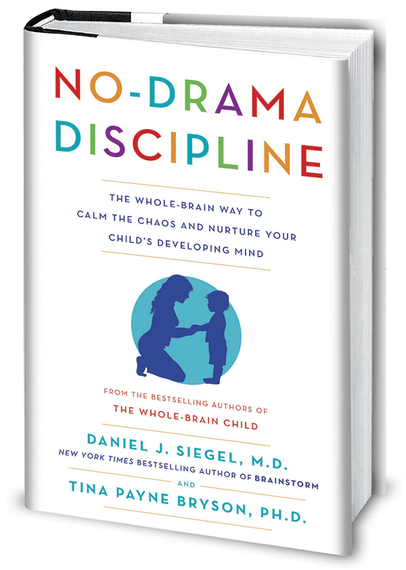
We recently wrote an article for TIME Magazine online where we discussed time-outs as a discipline strategy. We've received a great deal of positive feedback on the piece, and some criticism as well. We're excited that people are thinking and talking about the important ways that parents interact with and influence their children in discipline moments, but we'd also like to clear up any confusion about our position on time-outs. So here are our responses to four questions we've received since the article's debut.
1. Are you equating time-outs with child abuse?
Absolutely not.
As we state in the TIME article: "Brain imaging shows that the experience of relational pain -- like that caused by rejection -- looks very similar to the experience of physical pain in terms of brain activity."
TIME chose the following subtitle without our review: "In a brain scan, relational pain -- that caused by isolation during punishment -- can look the same as physical abuse." This has caused confusion because we said in the text that relational and physical pain -- not relational pain and physical abuse -- look similar on a brain scan. We are referring to a 2003 UCLA study that showed activity in the dorsal anterior cingulate cortex produced by both relational pain and physical pain (Eisenberger, N.I. et al.).
2. Do you believe that time-outs are hurting children?
It all depends on what you mean by the term "time-out."
TIME chose to make "Time-Outs Are Hurting Your Child" the title of our article (without our review), and this has also caused confusion.
The "appropriate" use of time-outs calls for brief, infrequent, previously explained breaks from an interaction used as part of a thought-out parenting strategy that is followed by positive feedback and connection with a parent. This seems not only reasonable, but it is an overall approach supported by the research as helpful for many children. However, in actual practice it seems that many parents instead use what we can term an "inappropriate" or "punitive time-out" as the popular go-to reaction, which unfortunately often appears to be frequent, prolonged and done as a punishment and coupled with parental anger and frustration.
Sadly, as a culture we use the same term "time-out" for each of these appropriate and inappropriate applications. The research that supports the positive use of appropriate time-outs as part of a larger parenting strategy is extensive; but as far as we know, there is no research on the inappropriate use of punishing time-outs as defined above.
We are not supportive of this all-too-common, inappropriate use of punitive time-outs. We do respect the research on appropriate usage -- which seems too often not its common usage. One goal of our article was to raise concern that parents should become aware of how they understand and apply "time-outs" as a parenting practice. The inappropriate use of time-outs, in our view, is likely to be unhelpful at best, quite disconnecting for a child, and not supportive of their development of emotional skills or closeness with the parent. Such an inappropriate use of time-out is a missed opportunity for teaching important life skills.
We believe that there are usually better options than this often inappropriate use of time-outs when it comes to achieving the dual goals of discipline: (1) to help kids cooperate in the moment, and (2) to build lifelong skills like self-discipline, responsibility, empathy, and ethical behavior. As we explained in the article, time-outs may often be handed down in moments of parental anger -- not as a part of an intentional parenting strategy with many other components. In these inappropriate cases of intense parental verbal and emotional hostility and repeated humiliation and isolation for a child, when kids are left alone to suffer for prolonged periods of time, when parents use them frequently and without following with a positive connection, we do believe that time-outs may be harmful when they are not being used as was initially supported by careful empirical research.
3. So are you against time-outs?
We are against the inappropriate use of time-outs.
Time-outs were initially designed to help children calm down so they can reflect on and change their behavior as part of a larger parenting strategy. Research supports the efficacy of time-outs when executed correctly. If parents use them appropriately as suggested in the research -- infrequently, calmly, with lots of support and connection and positive support -- then we are all for that. However, based on our years of experience of working with families, we've found that time-outs are often used in a reactive and punitive manner that leaves children feeling more reactive and dysregulated.
4. So what do you recommend instead?
Our ultimate goal in the article, and in our book No-Drama Discipline, is to help kids feel more loved and nurtured -- even when they've misbehaved -- thereby making life and discipline less difficult for parents. Emotional competencies emerge from being present with children, especially during times of distress as supported by the research on the importance of promoting reflection and conversation on internal emotional states with children. Having kids reflect on and talk about their emotions, what we are calling "time-in," has been demonstrated in a wide range of studies to support the important development of emotion understanding. We therefore encourage parents to comfort and soothe and connect with their children during times of distress, and to reflect afterwards on their inner experience as a "time-in" with reflective dialogue, rather than punitively isolating them in a moment of anger and without any opportunity for reflection and connection.
Since the goal of discipline is to teach, and to build skills so kids make better decisions both now and in the future, we need to pay attention to their emotions, and to the feelings behind the behavior. In fact, it's often when they are upset or out of control that they need us most. Our suggestion is simple: Connect and Redirect. For us, that's what discipline comes down to. Yes, we have to say no to certain behaviors and offer clear boundaries and structure as parents. But even as we do so, we always want to say yes to children's emotions, and to their experiences with the world.
As we put it in No-Drama Discipline: "We're not saying that short timeouts are the worst possible discipline technique, that they cause trauma, or that there's never an instance to use them." We do believe, though, that inappropriate time-outs as they're practiced by many parents end up being short on connection, and less effective when it comes to successful redirection. The times that are most challenging for us as parents -- the times when we must discipline our kids -- are the times we have the greatest ability to support and shape a child's growing brain. So our goal is to help turn the hardest and most aggravating moments into what is most important and rewarding in the long run.
Additional references:
- Eisenberger, N.I., Lieberman, M.D., & Williams, K.D. (2003). Does rejection hurt: An fMRI study of social exclusion. Science, 302, 290-292.
- Greenberg, M.T., Kusche, C.A., Cook, E.T., & Quamma, J.P. (1995). Promoting emotional
competence in school-aged children: The effects of the PATHS curriculum. Development and Psychopathology, 7, 117-136.
- Gottman, J.M., Katz, L.F., & Hooven, C. (1997). Meta-emotion: How families communicate
emotionally. Mahway, NJ: Erlbaum.
- Havighurst, S.S., Wilson, K.R., Harley, A.E., Prior, M.R. (2009): Tuning in to kids: An emotion-focused parenting program--initial findings from a community trial. Journal of Community Psychology, 37 (8): 1008-1023.
- Tenenbaum, H., Alfier, L, Brooks, P.J, and Dunner, G., (2008): The effects of explanatory conversations on children's emotion understanding. British Journal of Developmental Psychology 26, 249-263;
- Beardsall, L. (1991). Family talk about feeling states and children's later
understanding of others' emotions. Developmental Psychology, 27, 448-455.
- Denham, S. A., Blair, K. A., & Demulder, E. (2003). Preschool emotional competence: Pathway to
social competence. Child Development, 74, 238-256.
- Denham, S.A., Workman, E., Cole, P.M., Weissbrod, C., Kendziora, K.T., & Zahn-Waxler, C.
(2000). Prediction of externalizing behavior problems from early to middle childhood: The
role of parental socialization and emotion expression. Development and Psychopathology,
12, 23-45
- Denham, S. A., Zoller, D., & Couchoud, E. A. (1994). Socialization of preschoolers' emotion
understanding. Developmental Psychology, 30, 928-936.
- de Rosnay, M., & Hughes, C. (2006). Conversation and theory of mind: Do children talk their way
to social-cognitive understanding? British Journal of Developmental Psychology, 24, 7-37.
- Dunn, J. (2004). The development of individual differences in understanding emotion and
mind: Antecedents and sequelae. In A.S.R. Manstead, N. Frijda, & A. Fischer (Eds.),
Feelings and emotions: The Amsterdam symposium (pp. 303-320). New York/Cambridge:
Cambridge University Press.
- Eisenberg, N. (2001). The core and correlates of affective social competence. Social
Development, 10(1), 120-124.
- Eisenberg, N., Cumberland, A., & Spinrad, T.L. (1998). Parental socialization of emotion.
Psychological Inquiry, 9, 241-273.
- Dunn, J., Brown, J., & Laible, D. (2004). Mother-child discourse in two contexts: Links with child temperament, attachment security, and socioemotional competence. Developmental Psychology, 40, 979-992.
- Lundahl, B., Risser, H.J., & Lovejoy, M.C. (2006). A meta-analysis of parent training:
Moderators and follow-up effects. Clinical Psychology Review, 26(1), 86-104.
- Morris, A.S., Silk, J.S., Steinberg, L., Myers, S.S., & Robinson, L.R. (2007). The role of the family
context in the development of emotion regulation. Social Development, 16, 361-388.
- Ramsden, S.R., & Hubbard, J.A. (2002). Family expressiveness and parental emotion coaching:
Their role in children's emotion regulation and aggression. Journal of Abnormal Child
Psychology, 30, 657-667.
- Ruffman, T., Slade, L., & Crowe, E. (2002). The relation between children's and mothers' mental
state language and theory-of-mind understanding. Child Development, 73, 734-751.
- Shipman, K.L., Schneider, R., Fitzgerald, M.M., Sims, C., Swisher, L., & Edwards, A. (2007).
Maternal emotion socialization in maltreating and non-maltreating families: Implications
for children's emotion regulation. Social Development, 16, 268-285.
- Taumoepeau, M., & Ruffman, T. (2006). Mother and infant talk about mental states relates to desire language and emotion understanding. Child Development, 77, 465-481.
You can learn more about No Drama Discipline and Dr. Dan Siegel at www.DrDanSiegel.com.